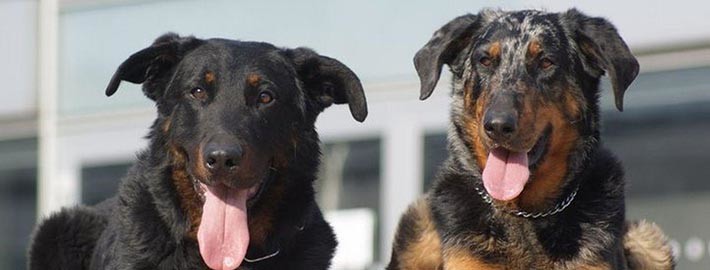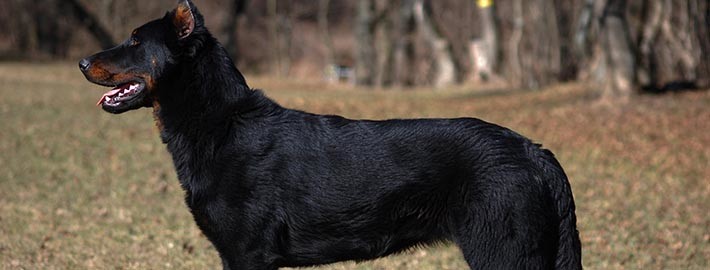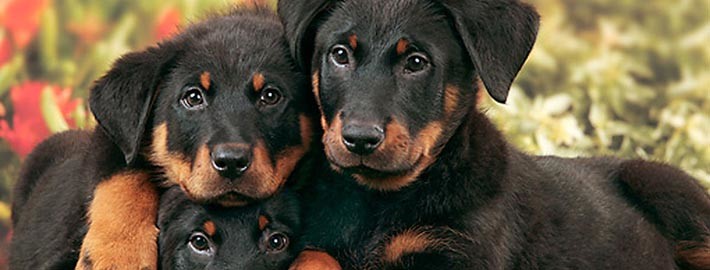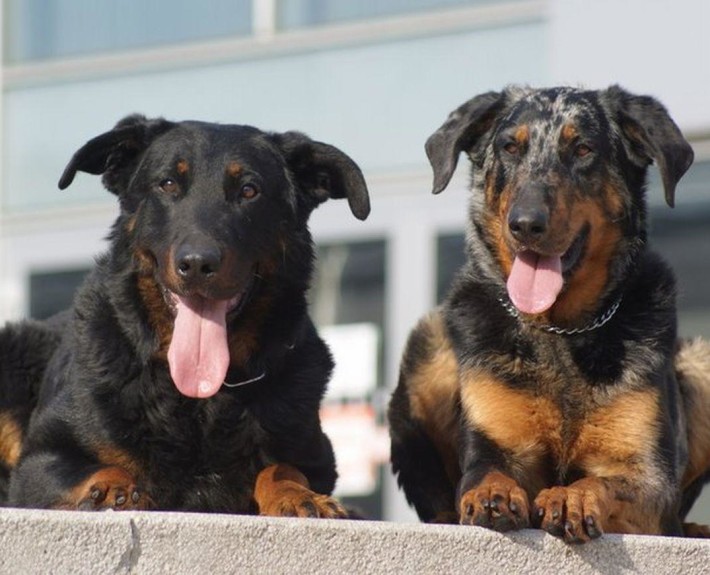What makes the Beauceron Unique?
These intelligent French herding dogs have been popular in their homeland for centuries. Beaucerons do well in a variety of dog sports and make excellent pets for farm families in cooler climates.
Breed Groups
Page Contents
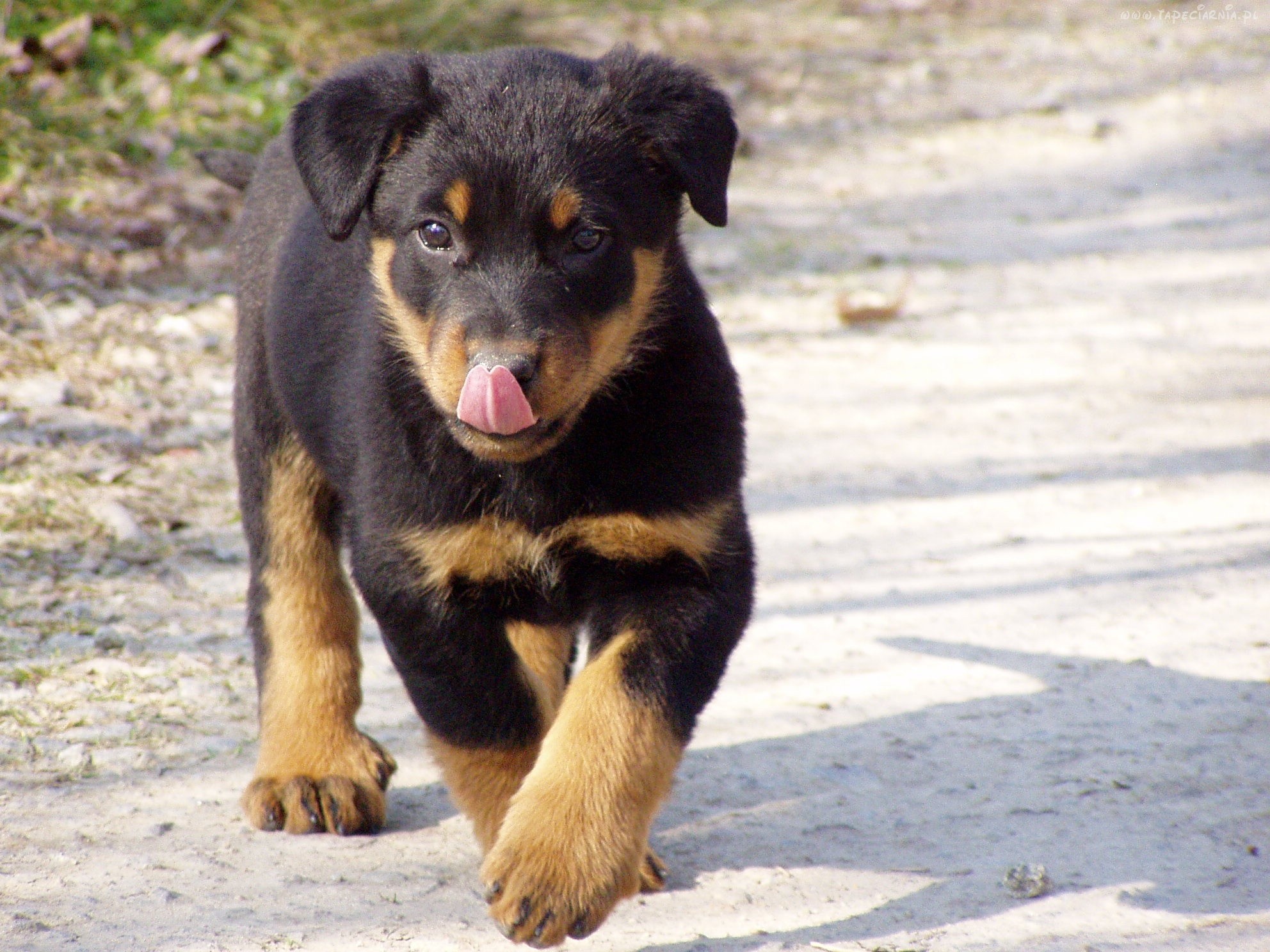
SnapShot
| Size: | Males – 66 to 71 cm (26 to 28 inches) Females – 64 to 66 cm (25 to 26 inches) |
| Weight: | Males – 32 to 45 kg (70 to 100 pounds) Females – 30 to 39kg (66 to 85 pounds) |
| Origin: | France |
| Life Span: | 10 – 12 Years |
| Colour: | Black with tan markings, or black and mottled grey with tan markings |
| Litter Size: | 6 to 7 puppies |
Is the Beauceron Right For You?
The Beauceron is known in France as a guard dog, a helper around the farm (herding sheep or cattle), and/or a ring sport dog (primarily protection training). This athletic, healthy and long-lived breed has been bred to be intelligent, calm, gentle, and fearless.[4] Adults are typically suspicious of strangers and are excellent natural guard dogs. On the other hand they typically take their cue from their handlers when it comes to greeting strangers, and are neither sharp nor shy. They do best when raised within the family but they can sleep outside, the better to act as guards (their weatherproof coats make them ideal dog kennel users even in the coldest winters. Beaucerons are uncannily intelligent and adept at any task involving learning, memory, and reasoning. They are courageous and calm, and make reliable, thoughtful guardians. This is an extremely loyal breed that is eager to please its family; however, if not properly trained, the Beauceron can run the family. Beaucerons are patient with children, but can be overwhelming to them or try to herd them.
In 5 Words
- Protective
- Friendly
- Calm
- Fearless
- Intelligent
Characteristics
Learn About the Beauceron
General Description
Beaucerons are solidly built, well-balanced dogs that have served many different purposes over the centuries. These dogs have strong jaws, a trait that is no doubt useful when dealing with livestock predators. This breed is also known for its agility. Beaucerons can cover a lot of ground while maintaining a fluid gait. When in motion, the dog’s head will be lowered to the back level as is typical for herding breeds. These dogs have a straight but coarse outer coat of medium length. It is combined with a dense, silky undercoat that helps Beaucerons withstand various weather conditions. While the unusual double dewclaws on the hind legs of these dogs serve no functional purpose, this seems to be a French tradition for livestock guardian breeds and could possibly have denoted superior herders at one time. This feature is now a trademark of the breed.
Size
Both male and females of this breed should measure between 61 and 70 centimeters (24 to 27.5 inches) at the withers. These dogs will weigh between 30 and 45 kilograms (66 and 100 pounds) on average.
Coat
The standard coloring for Beaucerons is either tan and grey or black and tan. The latter color combination is known in French as “rouge ecureuil”, or squirrel-red. The breed standards now ban formerly prevalent colorations such as grey, tawny, or grey and black. Harlequin coats are acceptable. These feature patches of gray, black and tan. Dogs with harlequin coats should have more black than gray and no white spots. In the black and tan dogs, the tan markings are heavily regulated by the breed standards.
Short History of the Beauceron
Used to hunt wild boar in its early years, the Beauceron is a dog that originated entirely in France. In fact, a Renaissance manuscript from around 1578 is the first written description of this dog breed. Many years later in 1809, a priest named Abbe Rozier wrote an article on French herding breeds. He named the long haired variety Berger de la Brie and the short haired variety Berger de la Beauce after regions in the country. These dog breeds are now called the Briard and the Beauceron.
Large herds of sheep and cattle were common in France during the early portion of the 19th century, given the then named Berger de la Beauce breed a chance to prove its worth. In 1882, the French Societe Centrale Canine was founded and the club registered its first Berger de Beauce eleven years later. In 1888, the breed began to be called “Beauceron”. These dogs served as messengers during both the world wars, because they were known to be obedient, easily trainable, and wary of landmines. The American Kennel Club recognized the breed in 2007
Temperament
Beaucerons are a smart breed that learns quickly. Bred to be livestock guardians, this athletic breed is both calm and courageous. While these dogs are extremely loyal and eager to please, they also can end up being in charge of more than they should if they are not correctly trained. They are best with older children because, despite being a patient shepherd, Beaucerons may try to herd children. This breed gets along with other family dogs and pets but is wary of unfamiliar animals.
Adult Beaucerons are naturally suspicious of all strangers but will take their cue from their human family members as to how to react in certain situations. These fearless dogs prefer to be raised as member of the family, but can sleep outdoors in order to guard the livestock. They are also excellent kennel dogs due to their weatherproof coats which can withstand even the coldest temperatures. In France, Beaucerons serve as guardians and livestock dogs. They are also good at ring sports.
Caring for Your Beauceron
General Health
Hip dysplasia, elbow dysplasia, gastric torsion, and bloat can be problematic in this breed. Although cancer holds the record for the highest fatality rate among dogs, bloat is the second most common deadly ailment in these pets and Beaucerons can be particularly susceptible to this illness because of their deep chests.
Grooming & Bathing
A bath every three to four months with a mild shampoo will be sufficient. Owners should note that this breed sheds heavily in both the spring and fall. More frequent brushing is required at such times of the year.
Exercise & Training
Beaucerons enjoy spending time with their human families. They do best when they have access to both indoor and outdoor areas. If these dogs do not receive sufficient exercise, they can become destructive. Beaucerons are well suited to environments where there is a job for them to do. These dogs are very good at sports but expect strong leadership from their owners. The easiest way to find a Beauceron who will excel at any given activity is to find a breeder who has produced dogs that are successfully competing in that sport. Prospective owners should bear in mind that a great deal of training is needed in order to bring dogs up to speed for competitions.
These eager learners can easily be trained to high levels of competency. However, owner should be aware that this breed does not mature mentally or physically until they are about three years old. Training a Beauceron therefore takes time. These dogs learn best with short training sessions a few times a day in their early years rather than by participating in extensive or rigorous training sessions.
Information Sources: Previously written materials, Wikipedia, American Kennel Club’s webpage, Animal Planet
Daily
This highly active breed will require plenty of exercise and mental stimulation on a daily basis.
Weekly
Their ears will need to be checked every week and cleaned if they are dirty. Beaucerons should be brushed twice a week with a natural bristle brush or rubber hound mitt to remove loose hairs because they shed year round.
It is also a good idea to frequently clean these dogs’ teeth to promote fresh breath and healthy gums.
Monthly
Beaucerons need their toenails clipped about once a month. Like any other dog breed, they need flea, tick and heartworm medications on a monthly basis as well.

